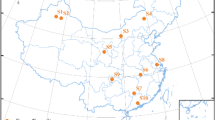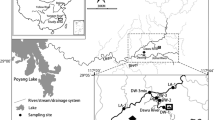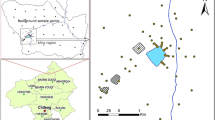Abstract
To better understand the general behavior of heavy metals in semi-aerobic incinerator residue landfills, we developed a general equation for calculating the mass balance of heavy metals (cadmium, lead, copper, zinc, mercury, and chromium) based on monitoring data from incineration plants and landfill sites. The mass balance results showed that 0.0042%, 0.001%, 0.0004%, 0.0019%, 0.022%, and 0.0065% of the disposed Cd, Pb, Cu, Zn, Hg, and Cr, respectively, were washed out by rainfall from 1975 to 2015. Heavy metals (Cd, Cr, and Hg) with a lower total mass in the landfill had a relatively high total leaching rate. This may be because of the high pH of the landfill, which affected the leaching of Pb, Zn, and Cu. According to our analysis of the changes in annual leaching rates at this landfill site, there was an obvious change in those of Cu, Zn, and Pb after 1989, when the pH of the leachate increased suddenly. The overall annual leaching rate became more stable, at around 0.00002%, following closure of the landfill site, and it is believed that the dissolvable fraction and heavy metal concentration in the leachate are expected to reach a limit under the current conditions.








Similar content being viewed by others
References
Luo H, Cheng Y, He D, Yang EH (2019) Review of leaching behavior of municipal solid waste incineration (MSWI) ash. Sci Total Environ. https://doi.org/10.1016/j.scitotenv.2019.03.004
Dou X, Ren F, Nguyen MQ, Ahamed A, Yin K, Chan WP, Chang VWC (2017) Review of MSWI bottom ash utilization from perspectives of collective characterization, treatment and existing application. Renew Sustain Energy Rev 79:24–38. https://doi.org/10.1016/j.rser.2017.05.044
Hjelmar O (1996) Disposal strategies for municipal solid waste incineration residues. J Hazard Mater 47(1–3):345–368. https://doi.org/10.1016/0304-3894(95)00111-5
Bank W (1999) Municipal solid waste incineration. Technology guidance report. The World Bank, Washington
Goh AT, Tay JH (1993) Municipal solid-waste incinerator fly ash for geotechnical applications. J Geotech Eng 119(5):811–825. https://doi.org/10.1061/(ASCE)0733-9410(1993)119:5(811)
Tanaka N, Tojo Y, Matsuto T (2005) Past, present, and future of MSW landfills in Japan. J Mater Cycles Waste Manag 7(2):104–111. https://doi.org/10.1007/s10163-005-0133-6
Ikeguchi T (1994) Progress in sanitary landfill technology and regulations in Japan: a review. Waste Manag Res 12(2):109–127. https://doi.org/10.1006/wmre.1994.1002
Chong TL, Matsufuji Y, Hassan MN (2005) Implementation of the semi-aerobic landfill system (Fukuoka method) in developing countries: a Malaysia cost analysis. Waste Manag 25(7):702–711. https://doi.org/10.1016/j.wasman.2005.01.008
Rani DA, Boccaccini AR, Deegan D, Cheeseman CR (2008) Air pollution control residues from waste incineration: current UK situation and assessment of alternative technologies. Waste Manag 28(11):2279–2292. https://doi.org/10.1016/j.wasman.2007.10.007
Roessler JG, Townsend TG, Kanneganti A (2017) Waste to energy ash monofill mining: an environmental characterization of recovered material. J Hazard Mater 328:63–69. https://doi.org/10.1016/j.jhazmat.2017.01.011
Xiong Y, Takaoka M, Sano A, Kusakabe T, Yang J, Shiota K, Oshita K (2019) Distribution and characteristics of heavy metals in a first-generation monofill site for incinerator residue. J Hazard Mater. https://doi.org/10.1016/j.jhazmat.2019.04.019
Inanc B, Inoue Y, Yamada M, Ono Y, Nagamori M (2007) Heavy metal leaching from aerobic and anaerobic landfill bioreactors of co-disposed municipal solid waste incineration bottom ash and shredded low-organic residues. J Hazard Mater 141(3):793–802. https://doi.org/10.1016/j.jhazmat.2006.07.042
Aziz SQ, Aziz HA, Yusoff MS, Bashir MJ, Umar M (2010) Leachate characterization in semi-aerobic and anaerobic sanitary landfills: a comparative study. J Environ Manag 91(12):2608–2614. https://doi.org/10.1016/j.jenvman.2010.07.042
Sabbas T, Polettini A, Pomi R, Astrup T, Hjelmar O, Mostbauer P, Heuss-Assbichler S (2003) Management of municipal solid waste incineration residues. Waste Manag 23(1):61–88. https://doi.org/10.1016/S0956-053X(02)00161-7
Kim SY, Matsuto T, Tanaka N (2003) Evaluation of pre-treatment methods for landfill disposal of residues from municipal solid waste incineration. Waste Manag Res 21(5):416–423. https://doi.org/10.1177/0734242X0302100504
Klein R, Baumann T, Kahapka E, Niessner R (2001) Temperature development in a modern municipal solid waste incineration (MSWI) bottom ash landfill with regard to sustainable waste management. J Hazard Mater 83(3):265–280. https://doi.org/10.1016/S0304-3894(01)00188-1
Piantone P, Bodénan F, Chatelet-Snidaro L (2004) Mineralogical study of secondary mineral phases from weathered MSWI bottom ash: implications for the modelling and trapping of heavy metals. Appl Geochem 19(12):1891–1904. https://doi.org/10.1016/j.apgeochem.2004.05.006
Saffarzadeh A, Shimaoka T, Wei Y, Gardner KH, Musselman CN (2011) Impacts of natural weathering on the transformation/neoformation processes in landfilled MSWI bottom ash: a geoenvironmental perspective. Waste Manag 31(12):2440–2454. https://doi.org/10.1016/j.wasman.2011.07.017
Belevi H, Baccini P (1988) Long-term behavior of municipal solid waste landfills. Waste Manag Res 7:43–56
Belevi H et al (1992) Chemical behavior of municipal solid waste incinerator bottom ash in monofills. Waste Manag Res 10:153–167
Chun SK (2018) Mass balance analysis on the behavior of major elements disposed at a waste landfill site. Waste Manag 71:233–243. https://doi.org/10.1016/j.wasman.2017.10.050
Øygard JK, Måge A, Gjengedal E (2004) Estimation of the mass-balance of selected metals in four sanitary landfills in Western Norway, with emphasis on the heavy metal content of the deposited waste and the leachate. Water Res 38(12):2851–2858. https://doi.org/10.1016/j.watres.2004.03.036
Øygard JK, Gjengedal E, Måge A (2005) Mass-balance estimation of heavy metals and selected anions at a landfill receiving MSWI bottom ash and mixed construction wastes. J Hazard Mater 123(1–3):70–75. https://doi.org/10.1016/j.jhazmat.2005.04.022
He PJ, Xiao Z, Shao LM, Yu JY, Lee DJ (2006) In situ distributions and characteristics of heavy metals in full-scale landfill layers. J Hazard Mater 137(3):1385–1394. https://doi.org/10.1016/j.jhazmat.2006.04.033
Cossu R, Stegmann R (2019) Solid waste landfilling. E&FN SPON, Padova
Zhu F, Takaoka M, Shiota K, Oshita K, Kitajima Y (2008) Chloride chemical form in various types of fly ash. Environ Sci Technol 42(11):3932–3937. https://doi.org/10.1021/es7031168
Environmental Protection Agency of United States (2000) Guidance for data quality assessment, Washington, DC
Feng X, Tang S, Li Z, Wang S, Liang L (2004) Landfill is an important atmospheric mercury emission source. Chin Sci Bull 49(19):2068. https://doi.org/10.1360/04wd0038
Lindberg SE, Price JL (1999) Airborne emissions of mercury from municipal landfill operations: a short-term measurement study in Florida. J Air Waste Manag Assoc 49(5):520–532. https://doi.org/10.1080/10473289.1999.10463825
Nishikawa M, Shiraishi H, Yanase R, Tanida K (1999) Examination of an improved passive sampler for gaseous mercury on the landfill site. J Environ Chem 9(3):681–684. https://doi.org/10.5985/jec.9.681
Yang J, Takaoka M, Sano A, Matsuyama A, Yanase R (2018) Vertical distribution of total mercury and mercury methylation in a landfill site in Japan. Int J Environ Res Public Health 15(6):1252. https://doi.org/10.3390/ijerph15061252
Acknowledgements
This research was financially supported by the Environment Research and Technology Development Fund (Project nos. 3K143002 and 3-1701). The authors thank the local government staff and landfill administrators for their hard work and support.
Author information
Authors and Affiliations
Corresponding author
Additional information
Publisher's Note
Springer Nature remains neutral with regard to jurisdictional claims in published maps and institutional affiliations.
Electronic supplementary material
Below is the link to the electronic supplementary material.
Rights and permissions
About this article
Cite this article
Xiong, Y., Takaoka, M., Kusakabe, T. et al. Mass balance of heavy metals in a non-operational incinerator residue landfill site in Japan. J Mater Cycles Waste Manag 22, 354–364 (2020). https://doi.org/10.1007/s10163-020-00976-w
Received:
Accepted:
Published:
Issue Date:
DOI: https://doi.org/10.1007/s10163-020-00976-w




